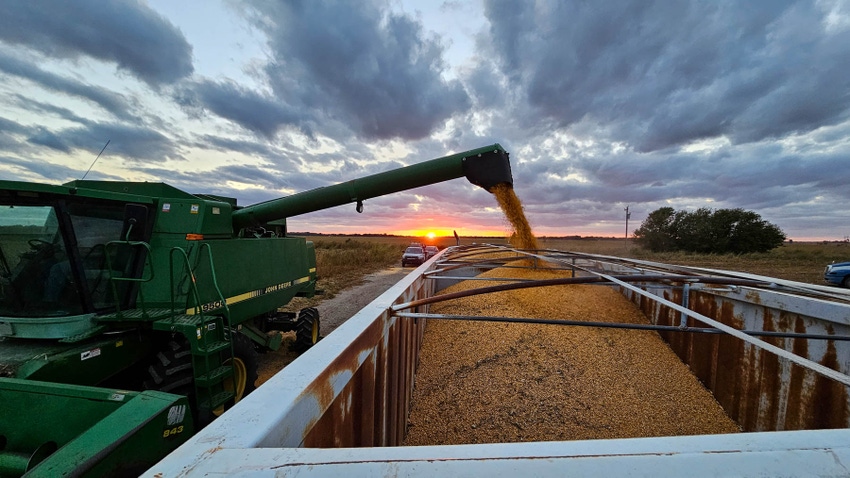
Monitoring markets, managing production costs, and working with elevator managers to find a few cents on basis could be keys to making a profit in grain markets this year.
“Nickels and dimes may mean a lot for selling grain crops in 2024,” says Texas A&M AgriLife Extension Marketing Specialist Mark Welch, College Station.
Several factors weigh on wheat, corn, and soybean markets, Welch says.

Texas A&M AgriLife Extension Marketing Specialist Mark Welch, College Station (Photo by Shelley E. Huguley)
Domestically, production prospects and growing stocks- to-use ratio put a damper on market upticks, he says. Wheat export opportunities are thwarted by Russia’s cheap wheat. “Russia is exporting record levels of very cheap wheat. Exports this year are above where they were before the invasion. It is incredible the wheat supplies moving out of the Black Sea region, some from Ukraine, but Russia holds all the cards.”
Promising crop prospects
Domestically, 2024 wheat prospects look good, Welch says.
“Crop conditions in the Southern Plains, Kansas, Eastern Colorado, Oklahoma, and Texas, are significantly above a year ago, better than average.”
Welch says Kansas is particularly interesting. “Kansas is the number one hard red winter wheat-producing state. The last time Kansas set a record wheat yield was 2016, an El Nino winter. This year’s El Nino winter is the second strongest since 2015/16. And wheat condition ratings this winter into early spring are better than they were in 2016.
“It’s still a long way to go; we could have a surprise like an Easter or April freeze, but those crop condition ratings, the share of crop rated good and excellent this winter and early spring, are better than 2016. Oklahoma also has tremendous crop ratings.”
Welch expects a “big rebound” in wheat production over last year. Much of that production moves to Houston and into the export market to compete with cheap wheat.
“Also, China is not buying wheat and just cancelled some sales,” he says.
Wheat producers also will compete with cheap corn for feed sales.
Disruptions move markets
Before wheat markets get much traction, “we will have to see something disrupt crop prospects,” Welch says. “An Easter freeze would do it, especially with crops a little further along. We haven’t had a bad winter, so if we are further along, a cold snap in early April could give us a price bump. Also, any war or shipping developments out of the Black Sea could disrupt markets.”
He says Texas producers have a problem with a below-average basis. “Weak export movements push our basis down even more. A below-average basis will persist unless new information changes the situation.”

The global stocks-to-use ratio for wheat heading into the 2024 harvest is still relatively tight, even though the U.S, crop is promising, said Mark Welch, Texas A&M AgriLife Extension marketing specialist.(Photo by Shelley E. Huguley)
Welch says the global stocks-to-use ratio for wheat heading into the 2024 harvest is still relatively tight, even though the U.S, crop is promising. “Stocks-to-use ratio is going up in the U.S., but we haven't seen that globally. It's been getting tighter in the last four or five years, and it's still tight. I think wheat is undervalued relative to the global stocks-to-use situation.”
Welch sees wheat prices trending from $5 to $6. “We could get a small rally between now and harvest. We usually see a little bump in April or May.”
Use options
Welch says wheat producers have options other than grain markets, and bumper yields could bail them out.
Record yields could be a lifesaver, he says. “Producers can hope this is one of those years that production compensates for low prices. With the good winter we’ve had, this could be an outstanding wheat year.”
He says producers might consider cutting wheat for silage or holding it for grazing. “It's not so much the price, it's the dollars per acre."
Feed grains
Welch says last year’s large corn crop and burdensome carryover numbers weigh on the market.
“Supply and demand tables from USDA show a carryover of more than 2 billion bushels of corn from last year."
Early guesses of 2024 planted acres are below 2023, but a trendline yield and large beginning stocks may add to the carryover for next year. Welch says last year the U.S. set a new corn yield record, despite severe production issues in Eastern and Northeastern Iowa in the middle of the growing season.
“This year, we could cut acreage, produce an average or better yield and add to the carryover. I anticipate record corn supplies next year whether we have a record production or not. Just with the carryover, we have record supply to deal with. If we have a normal growing year, what could the U.S. corn yield be?
Demand issues
“Whether it's wheat, corn, or soybeans, considering last year and projections for the 2024, potential increases in supply are outpacing anything going on in the demand columns right now,” Welch says.
He adds that any net increase in supply relative to use increases the downward pressure on prices and limits price gains. “Until something changes on the demand side, or a production problem occurs somewhere, it will be hard to gain any traction.

(Photo by Shelley E. Huguley)
“Good crops are overwhelming moderate growth in consumption. Whether it's feed, fuel, or food, there is some growth but not enough to keep up with just a normal production year globally.”
Market speculators, he says, continue to sell short. “This group of investors hold record net short positions (long contracts held minus short contracts held) in corn and soybeans since 2003.”
Price range
Welch expects Texas corn prices to range from $4.20 to $4.70, maybe $4.80 for areas with a better basis. “By October, if we end up at $4.40 on the board, that looks reasonable. A positive basis could offer potential to price some $4.80 corn.”
On the other hand, a big crop, a weaker basis, and elevators having trouble finding a place to put the crop, means $4.20 would be more likely. “That compares to a cost of production of $4.80 to $5 to cover total cost.”
Welch says if the market gets a bump of any kind, producers “should be paying close attention because that may be the only chance they get.”
Prospective planting reports out this week could offer some kind of surprise to offer a market bump and get traders to reposition.
Management issues
It is imperative, Welch says, for producers to manage costs. “They have to be as productive as possible with every input. They don't want to give up yield but they need to make every penny count.
“Also, monitor the markets and watch for marketing opportunities in an overall bearish market. Talk to your elevator manager. See if you can squeak out a nickel or a dime on basis.
“Watch for even a mini-market rally,” he adds. “We have time before we know what this crop will be, maybe into June. But monitoring market movements and picking up a nickel or a dime here and there could make a big difference.”
About the Author(s)
You May Also Like






